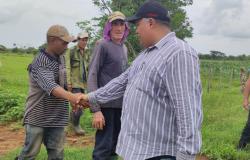CONICET specialists They published research in the journal Cladisticsin which they report the discovery of a new carnivorous dinosaur that lived in what is now the province of Chubut about 69 million years ago. Its about Koleken inakayali.
The work is part of the multidisciplinary project “The End of the Age of Dinosaurs in Patagonia”is supported by the National Geographic Society and more than 70 experts and scholarship holders from CONICET participate in the research. together with colleagues from other institutions in the country and from the United States and China.
He Koleken inakayalias they have called it, It belongs to the most important carnivorous dinosaur family in Gondwana.the southern hemisphere continent that included what are now South America, Africa, India and Madagascar, Australia and Antarctica.
As explained Diego Polwho led the Conicet work group, “it is an abelisaurid, a family popularized by the most famous dinosaur on our continent, the horned carnivore Carnotaurus”. This species differs from other carnivorous dinosaurs by its skull, which is smaller and does not have horns.
“Name Koleken It comes from the language of the Tehuelches and means it comes from clays and waterreferring to the fact that the sediments in which the fossil remains were found were clays deposited in an estuary 69 million years ago. Name inakayali pays tribute to the Tehuelche chief Inakayal”Pol remarked.
“The new dinosaur is represented by a partial skeleton that includes several bones of the skullan almost complete set of back bones, a complete hip, several tail bones and almost complete legs,” the scientist added.
The discovery was led by paleontologists and staff of the Egidio Feruglio Paleontological Museum, Trelew, in rocks belonging to the La Colonia geological formation, in the north of Chubut, an area rich in fossils. According to the researcher, “we found a concretion that contained the preserved rear half of the dinosaur skeleton. Surely the body of this animal was transported by a river to an estuary, where it was buried shortly after its death. In addition, we were able to find remains of the skull in the part of the concretion that had been eroded, which explains why the bones of the skull “They are disarticulated, while the rear part of the skeleton, which was inside the concretion, is perfectly articulated and in a life position.”.
The discovery sets the tone for a high level of diversity among carnivorous dinosaurs of the abelisaurid family. For Pol, “it is possible that Koleken has lived with his close relative Carnotaurusin the same way that today lions and leopards coexist in the African savanna or pumas and jaguars in the Misiones jungle. This is interesting because Koleken and Carnotaurus They lived very close to the time of the final extinction of the dinosaurswhich is indicating to us that at least in carnivores there was a great diversity of species until the moment of extinction.”
According to Pol, “this is interesting because it will lead us in the future to explore what could have influenced these increases.” so marked in the evolution of these carnivores”.
In this regard, another author of the work, paleontologist Mattia Antonio Baiano, from the Ernesto Bachmann Neuquén Municipal Museum, explains “Koleken reinforces the idea that several species of abelisaurids coexisted in the same habitats during that period. Furthermore, he shows that abelisaurids were very diverse compared to other dinosaur groups. “We thought these were the dominant carnivores when the great extinction occurred that wiped out the dinosaurs from our planet.”
Also the biologist and scientist Luis Cappozzo, director of the Argentine Museum of Natural Sciences, showed his enthusiasm for this new discovery led by scientists, fellows from Conicet. And many of them, in addition to Pol, work in the Museum’s research area. “Among the many relevant aspects that Dr. Pol has pointed out, I also find it interesting to highlight the relevance of the name that has been given to this new species. Because it recovers our identity and our origins, and also the origin of life in our country and our continent,” he said in dialogue with Page 12.
“At a time when science and culture are under attack, they have to shake hands. That is why we hope to be able to share this discovery in the Paleontology Room of the Museum of Natural Sciences. Because it is there where the public will be able to appreciate the multiplicity of disciplines involved in these findings, from paleontologists to technicians. Also, in its preservation and enhancement to be shared with the community,” Cappozzo highlighted.






